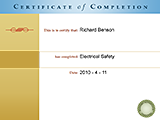Electrical Safety: What Everyone Should Know (HD)
- Product ID
- clmiewes
- Training Time ?
- 61 to 122 minutes
- Language(s)
- English,Spanish
- Video Format
- High Definition
- Required Plugins
- MasteryNet Player
- Lesson Interactions
- 14
- Quiz Questions
- 26
- Closed Captioning



Modern society cannot function without electricity, yet how electricity works is a mystery to many people. This high-definition video unravels the mystery behind electricity; building upon key principals as learning evolves. It explains the single mission of the electron, how people can protect themselves and others from electrical mishaps, what happens when the human body and electricity meet up, how to calculate the number of watts an electrical circuit can handle, the importance of cords and plugs, and how to limit potential electrical risks.
Learners are shown the path electricity takes through the tool's plug and wiring, back to the circuit breaker panel. The ground wire's role in snagging wayward electrons to redirect them to the ground harmlessly is explained. Because the human body is 50% - 60% water, and contains salt and minerals, we are excellent conductors of electricity. Without proper grounding, electricity can enter the body causing muscle paralysis, burning organs, disrupting the rhythms of the heart and causing death. Staying safe in the presence of electricity is accomplished using grounding, insulation, guarding and circuit protection devices. Participants learn low-resistance materials provide effective insulation from electrical current; guarding keeps people away from sources of electricity; grounding channels electricity back to the earth; and circuit protectors, including ground fault circuit interrupters (GFCI), monitor the flow of current and break it if the level is unsafe.
Protecting against shocks and fires due to overloaded circuits is much easier once the relationship between watts, amps and volts are understood. This relationship, expressed through a simple formula, enables people to determine how many watts a given circuit can handle. Properly matching plugs to extension cords is covered, as is the inverse relationship between an extension cord's gauge and the number of watts it can carry. Viewers are reminded to conduct pre-use safety checks of all electrical outlets, plugs and cords, to test GFCIs periodically and to look out for exposed wire, problems in circuit breaker panels and damaged outlets.
Electricity can enhance our lives and well-being when properly harnessed and used safely. Misdirected electricity can be deadly. This explanation of how electricity works and how to protect yourself and others from electrical accidents helps ensure everyone's safety.
![]() This course is in the Advantage™ format, to read about Advantage™ features click here.
This course is in the Advantage™ format, to read about Advantage™ features click here.

- Rich multimedia presentation with interactions and quiz
- Print certificate and wallet card
- You have 30 days to complete the course
Anyone who uses electrically powered tools and appliances
-
How Electricity Works
- Electricity basics
- Proper wiring
- The grounding wire
-
Effects of Electricity on the Human Body
- The human body and electric shock
- Injuries
-
Protection Devices
- Insulation
- Guarding
- Grounding
- Circuit protection devices
- Ground-fault
- Ground Fault Circuit Interrupters (GFCIs)
-
Using Electricity Safely
- Circuits
- Calculating power usage
- Discovering why an outlet trips
-
The Truth About Cords and Plugs
- Examining your cords and plugs
- Ground prongs
- Extension cords
- Polarized plugs
- Properly using cords and plugs
-
Other Potential Exposures
- Other exposures
- Stay clear of hazards
-
Recognize proper electrical wiring.
- Explain how electricity flows in a properly wired device.
- Identify the path of electrical current.
- Explain the purpose of the ground wire.
- Identify hazards of a missing ground wire.
-
Avoid coming in contact with an electrical current.
- Agree that the human body conducts electricity.
- Select injuries caused by electrical shock.
- Identify variables that affect bodily injuries when someone comes in contact with electrical current.
-
Use protection devices to avoid electrical shock or injury.
- Select insulating materials.
- Select common circuit breaker functions.
- Agree that ground-fault is the most common form of electric shock.
- Select likely causes of ground-faults.
- Evaluate the accuracy of a GFCI's purpose statement.
- Choose areas where GFCIs are used.
- Recognize that GFCIs can wear out or stop working.
-
Prevent electrical shocks and fires.
- Recognize the unit of measurement for power usage.
- Select the proper reduction amount of the total allowable Wattage when drawing continuous power.
- Calculate the amount of power being used.
- Identify proper steps to take if a tool trips a circuit.
- Evaluate amp circuit electrical capacity.
-
Safely use cords and plugs.
- Evaluate the current capacity of two different gauge cords.
- Recognize characteristics of a polarized plug.
- Agree that extension cords cannot be used for permanent wiring.
- Agree to comply with cord label instructions.
- Agree to keep all electrical equipment away from water.
-
Minimize potential exposures to electrical hazards.
- Identify potential exposures to electrical hazards
- Agree to stay clear of areas where electrical services are being performed.
© Mastery Technologies, Inc.




